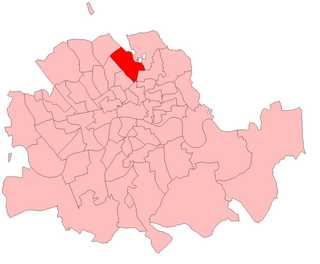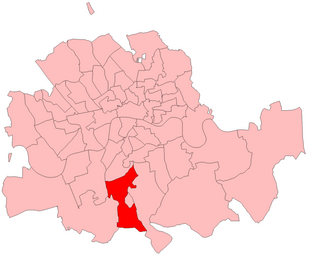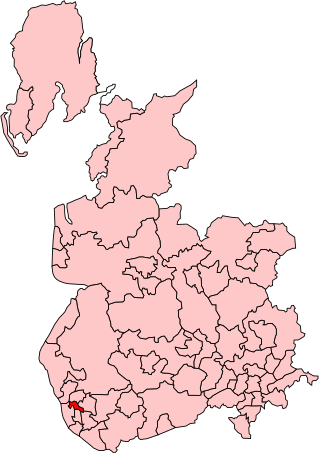Boundaries



1918–1950: The Metropolitan Borough of Islington wards of Lower Holloway and Thornhill.
| Islington West | |
|---|---|
| Former borough constituency for the House of Commons | |
| 1885–1950 | |
| Seats | one |
| Created from | Finsbury |
| Replaced by | Islington South West |
Islington West was a borough constituency in the Metropolitan Borough of Islington, in North London.
It returned one Member of Parliament (MP) to the House of Commons of the Parliament of the United Kingdom from 1885 until it was abolished for the 1950 general election. Elections were held using the first past the post voting system.



1918–1950: The Metropolitan Borough of Islington wards of Lower Holloway and Thornhill.
| Election | Member | Party | |
|---|---|---|---|
| 1885 | Richard Chamberlain | Liberal | |
| 1886 | Liberal Unionist | ||
| 1892 | Thomas Lough | Liberal | |
| 1918 | Sir George Elliott | Unionist | |
| 1922 | James Despencer-Robertson | Unionist | |
| 1923 | Frederick Montague | Labour | |
| 1931 | Patrick Donner | Conservative | |
| 1935 | Frederick Montague | Labour | |
| 1947 | Albert Evans | Labour | |
| 1950 | constituency abolished: see Islington South West | ||
| Party | Candidate | Votes | % | ±% | |
|---|---|---|---|---|---|
| Liberal | Richard Chamberlain | 3,470 | 60.6 | ||
| Conservative | George Danford Thomas [3] | 2,256 | 39.4 | ||
| Majority | 1,214 | 21.2 | |||
| Turnout | 5,726 | 78.7 | |||
| Registered electors | 7,276 | ||||
| Liberal win (new seat) | |||||
| Party | Candidate | Votes | % | ±% | |
|---|---|---|---|---|---|
| Liberal Unionist | Richard Chamberlain | 2,793 | 65.0 | +25.6 | |
| Liberal | William Archibald Macdonald [4] | 1,501 | 35.0 | −25.6 | |
| Majority | 1,292 | 30.0 | N/A | ||
| Turnout | 4,294 | 59.0 | −19.7 | ||
| Registered electors | 7,276 | ||||
| Liberal Unionist gain from Liberal | Swing | +25.6 | |||

| Party | Candidate | Votes | % | ±% | |
|---|---|---|---|---|---|
| Liberal | Thomas Lough | 3,385 | 56.0 | +21.0 | |
| Liberal Unionist | Richard Chamberlain | 2,655 | 44.0 | −21.0 | |
| Majority | 730 | 12.0 | N/A | ||
| Turnout | 6,040 | 72.2 | +13.2 | ||
| Registered electors | 8,365 | ||||
| Liberal gain from Liberal Unionist | Swing | +21.0 | |||
| Party | Candidate | Votes | % | ±% | |
|---|---|---|---|---|---|
| Liberal | Thomas Lough | 3,494 | 53.5 | −2.5 | |
| Liberal Unionist | George Barham | 3,031 | 46.5 | +2.5 | |
| Majority | 463 | 7.0 | −5.0 | ||
| Turnout | 6,525 | 72.9 | +0.7 | ||
| Registered electors | 8,950 | ||||
| Liberal hold | Swing | −2.5 | |||
| Party | Candidate | Votes | % | ±% | |
|---|---|---|---|---|---|
| Liberal | Thomas Lough | 3,178 | 50.1 | −3.4 | |
| Liberal Unionist | F H Medhurst | 3,159 | 49.9 | +3.4 | |
| Majority | 19 | 0.2 | −6.8 | ||
| Turnout | 6,337 | 69.8 | −3.1 | ||
| Registered electors | 9,074 | ||||
| Liberal hold | Swing | −3.4 | |||

| Party | Candidate | Votes | % | ±% | |
|---|---|---|---|---|---|
| Liberal | Thomas Lough | 4,116 | 53.2 | +3.1 | |
| Liberal Unionist | F H Medhurst | 3,618 | 46.8 | −3.1 | |
| Majority | 498 | 6.4 | +6.2 | ||
| Turnout | 7,734 | 83.8 | +14.0 | ||
| Registered electors | 9,229 | ||||
| Liberal hold | Swing | +3.1 | |||
| Party | Candidate | Votes | % | ±% | |
|---|---|---|---|---|---|
| Liberal | Thomas Lough | 3,768 | 51.7 | −1.5 | |
| Liberal Unionist | Savile Crossley | 3,514 | 48.3 | +1.5 | |
| Majority | 254 | 3.4 | −3.0 | ||
| Turnout | 7,282 | 85.2 | +1.4 | ||
| Registered electors | 8,544 | ||||
| Liberal hold | Swing | −1.5 | |||

| Party | Candidate | Votes | % | ±% | |
|---|---|---|---|---|---|
| Liberal | Thomas Lough | 3,549 | 54.3 | +2.6 | |
| Conservative | William George Black | 2,985 | 45.7 | −2.6 | |
| Majority | 564 | 8.6 | +5.2 | ||
| Turnout | 6,534 | 76.5 | −8.7 | ||
| Registered electors | 8,544 | ||||
| Liberal hold | Swing | +2.6 | |||
General Election 1914–15:
Another General Election was required to take place before the end of 1915. The political parties had been making preparations for an election to take place and by the July 1914, the following candidates had been selected;
| Party | Candidate | Votes | % | ±% | |
|---|---|---|---|---|---|
| C | Unionist | George Elliott | 4,996 | 45.4 | −0.3 |
| Liberal | Thomas Lough | 2,616 | 23.7 | −30.6 | |
| Labour | John Thomas Sheppard | 2,300 | 20.9 | New | |
| NFDDSS | Ernest Miles Taylor | 1,105 | 10.0 | New | |
| Majority | 2,380 | 21.7 | N/A | ||
| Turnout | 11,017 | 42.1 | −34.6 | ||
| Registered electors | 26,197 | ||||
| Unionist gain from Liberal | Swing | +15.2 | |||
| Cindicates candidate endorsed by the coalition government. | |||||
| Party | Candidate | Votes | % | ±% | |
|---|---|---|---|---|---|
| Unionist | James Despencer-Robertson | 7,335 | 38.9 | −6.5 | |
| Liberal | Henry Mills | 6,643 | 35.3 | +11.6 | |
| Labour | W. J. Lewington | 4,856 | 25.8 | +4.9 | |
| Majority | 692 | 3.6 | −18.1 | ||
| Turnout | 18,834 | 57.5 | +15.4 | ||
| Registered electors | 32,775 | ||||
| Unionist hold | Swing | −9.1 | |||
| Party | Candidate | Votes | % | ±% | |
|---|---|---|---|---|---|
| Labour | Frederick Montague | 7,955 | 41.4 | +15.6 | |
| Unionist | James Despencer-Robertson | 5,829 | 30.3 | −8.6 | |
| Liberal | Joseph William Molden | 5,443 | 28.3 | −7.0 | |
| Majority | 2,126 | 11.1 | N/A | ||
| Turnout | 19,227 | 57.7 | +0.2 | ||
| Registered electors | 33,351 | ||||
| Labour gain from Unionist | Swing | +12.1 | |||
| Party | Candidate | Votes | % | ±% | |
|---|---|---|---|---|---|
| Labour | Frederick Montague | 10,174 | 45.3 | +3.9 | |
| Unionist | James Despencer-Robertson | 9,499 | 42.3 | +12.0 | |
| Liberal | Joseph William Molden | 2,780 | 12.4 | −15.9 | |
| Majority | 675 | 3.0 | −8.1 | ||
| Turnout | 22,453 | 67.2 | +9.5 | ||
| Registered electors | 33,427 | ||||
| Labour hold | Swing | −4.1 | |||
| Party | Candidate | Votes | % | ±% | |
|---|---|---|---|---|---|
| Labour | Frederick Montague | 13,768 | 55.2 | +9.9 | |
| Unionist | James Despencer-Robertson | 6,921 | 27.7 | −14.6 | |
| Liberal | David Eifion Puleston Evans | 4,267 | 17.1 | +4.7 | |
| Majority | 6,847 | 27.5 | +24.5 | ||
| Turnout | 24,956 | 60.2 | −7.0 | ||
| Registered electors | 41,466 | ||||
| Labour hold | Swing | +12.3 | |||
| Party | Candidate | Votes | % | ±% | |
|---|---|---|---|---|---|
| Conservative | Patrick Donner | 14,487 | 59.22 | ||
| Labour | Frederick Montague | 9,977 | 40.78 | ||
| Majority | 4,510 | 18.44 | N/A | ||
| Turnout | 24,464 | 58.00 | |||
| Conservative gain from Labour | Swing | ||||
| Party | Candidate | Votes | % | ±% | |
|---|---|---|---|---|---|
| Labour | Frederick Montague | 11,340 | 55.00 | ||
| Conservative | Frederick Ponsonby | 9,280 | 45.00 | ||
| Majority | 2,060 | 10.00 | N/A | ||
| Turnout | 20,620 | 52.63 | |||
| Labour gain from Conservative | Swing | ||||
General Election 1939–40
Another General Election was required to take place before the end of 1940. The political parties had been making preparations for an election to take place and by the Autumn of 1939, the following candidates had been selected;
| Party | Candidate | Votes | % | ±% | |
|---|---|---|---|---|---|
| Labour | Frederick Montague | 11,496 | 73.8 | +18.8 | |
| Conservative | E.T. Hope | 4,090 | 26.2 | −18.8 | |
| Majority | 7,406 | 47.6 | +37.6 | ||
| Turnout | 25,926 | 60.1 | +7.5 | ||
| Labour hold | Swing | +18.8 | |||
| Party | Candidate | Votes | % | ±% | |
|---|---|---|---|---|---|
| Labour | Albert Evans | 8,760 | 57.2 | −16.6 | |
| Conservative | Tom Howard | 4,084 | 26.6 | +0.4 | |
| Liberal | Edwin Malindine | 2,459 | 16.0 | New | |
| Independent | L.J. Wildman | 33 | 0.2 | New | |
| Majority | 4,676 | 30.6 | −17.0 | ||
| Turnout | 29,859 | 51.4 | −8.7 | ||
| Labour hold | Swing | -8.5 | |||

Ilkeston is a former United Kingdom Parliamentary constituency. It was a constituency of the House of Commons of the Parliament of the United Kingdom. It was represented by one Member of Parliament. In 1983 it was abolished, together with South East Derbyshire, when the Derbyshire county constituencies were redrawn - the constituencies of Amber Valley and Erewash were created and the constituency of South Derbyshire was re-created.

Islington East was a constituency which returned one Member of Parliament (MP) to the House of Commons of the Parliament of the United Kingdom from 1885, until it was abolished for the February 1974 general election.

Salford South was a parliamentary constituency in the City of Salford in Greater Manchester from 1885 until 1950. It returned one Member of Parliament (MP) to the House of Commons of the Parliament of the United Kingdom.

Salford West was a parliamentary constituency in the City of Salford in Greater Manchester from 1885 until 1983. It returned one Member of Parliament (MP) to the House of Commons of the Parliament of the United Kingdom.

Norwood was a parliamentary constituency in south London which returned one Member of Parliament (MP) to the House of Commons of the Parliament of the United Kingdom by the first past the post system.

Hornsey was a constituency that returned one Member of Parliament (MP) to the House of Commons of the UK Parliament, 1885 — 1983. It was then largely replaced by Hornsey & Wood Green. Its voters using the first-past-the-post system elected the Conservative Party candidate at each election. Its closest result was a 1.29% majority at the 1966 election which saw the start of the Second Wilson Ministry. From 1945 onwards the runners-up in the seat were the Labour Party candidates.

Hackney Central was a borough constituency in what was then the Metropolitan Borough of Hackney, in London. It returned one Member of Parliament (MP) to the House of Commons of the Parliament of the United Kingdom.
Kingston or Kingston-upon-Thames was a parliamentary constituency which covered the emerging southwest, outer London suburb of Kingston upon Thames and which existed between 1885 and 1997 and returned one Member of Parliament (MP) to the House of Commons of the UK Parliament. The Conservative candidate won each election during its 112-year existence.
Liverpool Everton was a borough constituency represented in the House of Commons of the Parliament of the United Kingdom. It elected one Member of Parliament (MP) by the first past the post system of election.

Liverpool Kirkdale was a constituency represented in the House of Commons of the Parliament of the United Kingdom covering Kirkdale, Liverpool. It elected one Member of Parliament (MP) by the first past the post system of election.
Liverpool West Toxteth was a parliamentary constituency represented in the House of Commons of the Parliament of the United Kingdom. It elected one Member of Parliament (MP) by the first past the post system of election.
Blackpool was a parliamentary constituency centred on the town of Blackpool in Lancashire. It returned one Member of Parliament (MP) to the House of Commons of the Parliament of the United Kingdom.

Rotherhithe was a parliamentary constituency centred on the Rotherhithe district of South London. It returned one Member of Parliament (MP) to the House of Commons of the Parliament of the United Kingdom, elected by the first past the post system.
Woodbridge was a county constituency centred on the town of Woodbridge in Suffolk. It returned one Member of Parliament (MP) to the House of Commons of the Parliament of the United Kingdom.

Harrow was a constituency of the House of Commons of the UK Parliament 1885—1945 in Middlesex, a traditional county; it covered an area forming part of the north-west of today's Greater London. It returned one Member of Parliament (MP).
Birmingham Handsworth was a parliamentary constituency centred on the Handsworth district of Birmingham. It returned one Member of Parliament (MP) to the House of Commons of the Parliament of the United Kingdom. It was abolished in 1983.

Camberwell North was a borough constituency located in the Metropolitan Borough of Camberwell, in South London. It returned one Member of Parliament (MP) to the House of Commons of the Parliament of the United Kingdom. The constituency was created for the 1885 general election, and abolished for the 1950 general election.
Islington South was a parliamentary constituency in the Metropolitan Borough of Islington in North London. It returned one Member of Parliament (MP) to the House of Commons of the Parliament of the United Kingdom.
Thornbury was a county constituency centred on the town of Thornbury in Gloucestershire. It returned one Member of Parliament (MP) to the House of Commons of the Parliament of the United Kingdom, elected by the first past the post voting system.

Ealing was a parliamentary constituency centred on the Ealing district of west London. It returned one Member of Parliament (MP) to the House of Commons of the UK Parliament, 1885–1945. In common with metropolitan areas the seat saw major population increase. Until 1918 it included Chiswick, Acton within the County of London, and part of Hanwell in the rump of dwindling Middlesex.